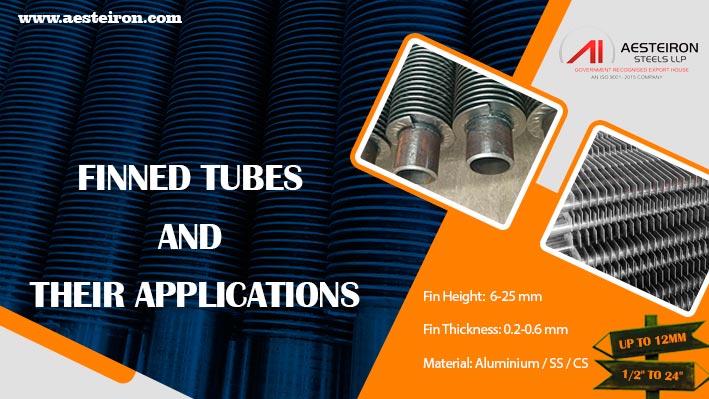
Finned tubes are widely used in applications where heat needs to be transferred from a hot fluid to a colder one across the tube wall. The efficiency of this heat transfer depends on several factors, including the temperature difference between the two fluids, the heat transfer capacity between the fluids and the tube wall, and the surface area available for heat exchange.
Table of contents
- What is finned tube?
- Different types of finned tubes
- Why Finned Tubes are made of Aluminum?
- Finned tube heat exchanger working principle
- Low fin tubes dimension
- Uses Of Helical solid finned tubes
- Advantages of Using Fin and tube heat exchangers
- G Type Finned Tube Features
- Quality Control for Stainless steel finned tube
- Size Range Of G Type Fin Tube
- Classification of Finned tubes based on process and fin shape
- High fin tubes Vs Low fin tubes
- What can Cause Leakages in Low Fin Tubes?
- What Affects the Heat Transfer in a Low Fin Tube?
What is finned tube?
Finned tubes are long tubes with small fins attached to their outer surface, acting as heat exchangers. These fins enhance the heat transfer process by increasing the surface area. They allow heat to flow both into and out of the tube, making them essential components in heat exchangers. These tubes are commonly used to transfer heat between thermally efficient fluids that can carry heat effectively.
View different types of fin tubes for heat exchangers
The table below provides an overview of various types of fin tubes used in heat exchangers. It will help you choose the right type for your specific application, ensuring optimal performance and functionality.
Different types of finned tubes
| Fin Type |
Icon |
Tube Material |
Fin Material |
Fin Height |
Fin Thickness |
Tube Diameter |
| Plain Finned |
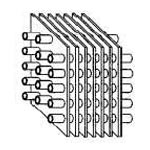 |
Carbon steel, stainless steel, copper, aluminum |
Aluminum, copper, stainless steel |
6-25 mm |
0.2-0.6 mm |
12.7 mm (1/2") to 63.5 mm (2.5") |
| L-Finned |
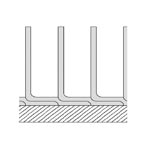 |
Carbon steel, stainless steel, copper |
Aluminum, copper, stainless steel |
6-19 mm |
0.3-0.5 mm |
15.9 mm (5/8") to 38.1 mm (1.5") |
| G-Finned |
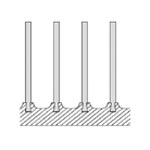 |
Carbon steel, stainless steel, alloy steel |
Aluminum, copper |
6-15 mm |
0.3-0.5 mm |
15.9 mm (5/8") to 50.8 mm (2") |
| Extruded Finned |
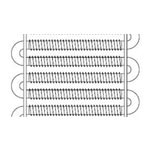 |
Aluminum, copper |
Aluminum |
8-16 mm |
0.4-1.2 mm |
12.7 mm (1/2") to 31.8 mm (1.25") |
| U-Tube Finned |
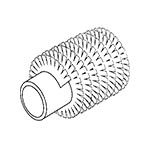 |
Carbon steel, stainless steel, alloy steel |
Aluminum, copper, stainless steel |
6-25 mm |
0.3-0.5 mm |
15.9 mm (5/8") to 38.1 mm (1.5") |
| Studded Finned |
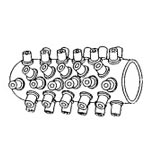 |
Carbon steel, stainless steel, alloy steel |
Carbon steel, alloy steel |
10-50 mm |
6-12 mm |
25.4 mm (1") to 114.3 mm (4.5") |
| Helical Finned |
 |
Carbon steel, stainless steel, copper, aluminum |
Aluminum, copper, stainless steel |
8-16 mm |
0.3-0.5 mm |
12.7 mm (1/2") to 76.2 mm (3") |
Refer sizes and uses of finned aluminum tubing
Finned aluminum tubing is commonly used in refrigeration systems, air conditioning, and industrial processes where heating and cooling are required. Its high heat transfer capability and durability make it a preferred choice over other types of heat exchangers.
Why Finned Tubes are made of Aluminum?
Aluminum finned tubes have a size range of 3/8″ to 1 1/2″.
Aluminum is widely used for manufacturing finned tubes due to its properties:
- Excellent thermal conductivity
- Lightweight
- Corrosion resistance
- Ductility and malleability
- Cost-effective
Finned tube heat exchanger working principle
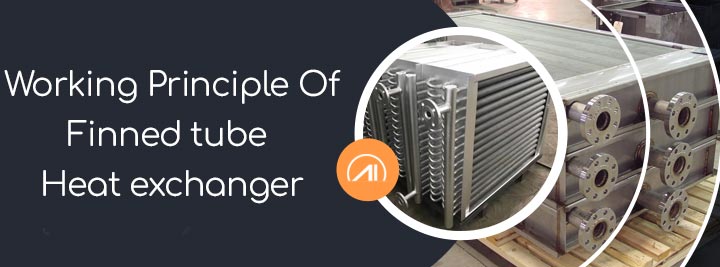
Finned tube heat exchangers are primarily used to transfer heat from one fluid to another through the tubes. The fins increase the surface area, which enhances the heat transfer efficiency.
Low fin tube has a fin of about 1/16th in height
A low fin tube is a standard tube with a small fin, typically around 1/16th of an inch in height. These fins are embedded within the tube wall and are commonly used in applications such as coolers, chillers, and condensers where liquid-to-liquid or liquid-to-gas heat transfer is needed.
Low fin tubes dimension
| Description |
Size dimension |
| Tube Outside Diameter |
Min. 12.7mm / Max. 31.75mm |
| Tube thickness (plain section) |
Min. 1.245mm / Max. 3.404mm |
| Fin pitch |
19 – 26 – 27 – 28 – 30 – 36 fins per inch |
| Fin height |
Max. 1,40mm |
| Tube length |
Max. 25000mm |
Welded Helical solid finned tubes widely used in petrochemical industry
These tubes offer resistance to corrosion, high pressure, and extreme temperatures, making them ideal for use in petrochemical industries and industrial boilers. They are often used to heat, cool, or recover heat from industrial exhaust systems.
Uses Of Helical solid finned tubes
- Petrochemical industries
- Natural gas processing
- Blast furnace and converter system
- Power generation
- Waste incinerators
- Air conditioning
- Compressor coolers
Advantages of Using Fin and tube heat exchangers
- Increases heat transfer rate
- Improves heat transfer coefficient
- Reduces equipment size
- Enhances cost-efficiency
- Increases outside surface area
G Type Finned Tube Features
- High fin stability
- Superior heat transfer efficiency
- Ability to operate at elevated temperatures
- Strong resistance to temperature changes
- Excellent thermal shock resistance
Quality Control for Stainless steel finned tube
- Chemical composition testing
- Dimensional inspection
- Flatten test
- Non-destructive testing
- Hydrostatic test
- Mechanical property testing
- Expansion test
- Surface quality check
Size Range Of G Type Fin Tube
| Base Tube Specification |
Fin Specification |
| Outside Diameter (mm) |
Wall Thickness (mm) |
Height (mm) |
Thickness (mm) |
Pitch (mm) |
| 15.88-50.8 |
1.0-3.0 |
6.35-25.4 |
0.4 |
2.1-6.0 |
| Material |
Material |
Length |
| SS, CS, Alloy Steel, Copper |
CS, Aluminum, Copper |
≤ 15m |
Classification of Finned tubes based on process and fin shape
| Tube Outside Diameter |
Fin Thickness |
Fin Height |
Fins per Pitch |
| 5/8 |
.015 / .016 / .020 |
3/8, 1/2 |
6, 7, 8, 9, 10, 11, 12 |
| 3/4 |
5/8, 1/2 |
| 1 |
5/8, 1/2 |
| 1 1/4 |
5/8, 1/2 |
| 1 1/2 |
5/8, 1/2 |
Finned tubes generally use air to cool or heat fluids such as water
Finned tubes significantly increase the surface area of the tube, allowing for more effective heat transfer with air. Using air for heating or cooling is beneficial because it is readily available, cost-effective, and eliminates the need for complex heating equipment or tools, which may require labor to operate.
High fin tubes Vs Low fin tubes
| Features |
High Fin Tubes |
Low Fin Tubes |
| Fin Density |
Higher fin density |
Lower fin density |
| Heat Transfer Efficiency |
Higher due to increased fin density |
Lower compared to high fin tubes |
| Surface Area-to-Volume Ratio |
Higher due to more fins |
Lower due to fewer fins |
| Maintenance and Cleaning |
Requires more frequent maintenance and cleaning |
Requires less maintenance due to spaced-out fins |
| Cost Considerations |
More expensive due to complex manufacturing |
More cost-effective |
What can Cause Leakages in Low Fin Tubes?
- Scale buildup: This narrows the inner diameter, causing pressure buildup and eventual leakage.
- Thermal shock: Rapid temperature changes can cause cracks or ruptures.
- Improper installation: Correct installation and regular maintenance can prevent leaks.
- Tube corrosion: Corrosion increases the risk of leakage.
What Affects the Heat Transfer in a Low Fin Tube?
Several factors influence the effectiveness and efficiency of heat transfer in low fin tubes:
- Fluid properties
- Fin arrangement
- Number of fins
- Dimensions of the fins
- Surface finish
Girl's Costumes
Girl'S Costumes,Girls Costumes,Fairy Dress Costumes,Girls Carnival Costumes
Leadtex Animation Creative Co., Ltd. , https://www.leadtex.com








